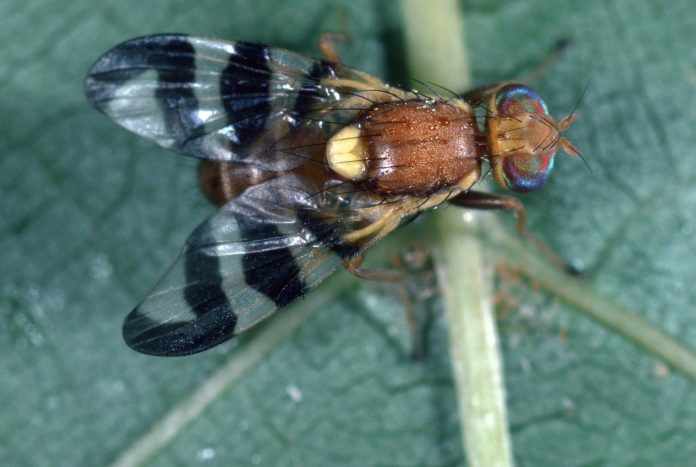
All walnut varieties are susceptible to damage from walnut husk fly (WHF). WHF are distinguished from other fruit fly varieties by their yellow coloring at the base of their wings and by the dark triangular band on their wing tips. Size is similar.
Damage to developing walnuts occurs after the female husk fly lays eggs inside the walnut husk. Feeding by larvae results in a soft and dark husk inside.
UCCE IPM advisor Jhalendra Rijal presented information on the biology, monitoring and control of this walnut pest for the West Coast Nut walnut conference.
Rijal said that WHF damage appears different than sunburn damage on walnut husks. Sunburn will cause a dry appearance, typically in the sun-exposed side of the nut, while nuts infested by WHF will appear soft and moist at the feeding site. Larval feeding inside the hull causes staining on shells and makes husks difficult to remove after harvest. Early season infestation can cause shriveled kernels.
WHF produce one generation per year. Adults emerge from soil in the summer months. Female WHF will feed on some sugar and nitrogen sources out in the orchard including aphids or bird feces for a week or so prior to laying eggs. Larvae hatch from eggs, feed on the husk and drop to the ground to pupate under the soil over winter.
Rijal said monitoring of adult WHF emergence is important to time insecticide applications for control. Yellow sticky traps with the attractant ammonium carbonate should be hung on the north side of the tree as high as possible and shaded by foliage. Check these traps two to three times per week to help to determine if WHF is emerging and laying eggs.
Rijal advised using a lens to identify female WHF in the traps. They are larger than the males and have light-colored segments on legs. Crushing their abdomen will reveal if they are carrying ‘rice-grain’ looking eggs.
Insecticide applications may be needed as soon as the first female WHF with eggs is found, depending on the orchard damage history, Rijal said.
The control materials target adult WHF and spray applications should be made before large numbers of egg-carrying females are found. The most effective control insecticides can be found at on the UC IPM web site.
Multiple applications may be necessary to cover the entire susceptible period as adult flies emerge over two to three months in the summer.
Rijal said research is needed to determine if cultural control (disking orchard soils to break life cycle) is possible or use of potential biocontrol agents such as insect pathogenic fungi or nematodes is needed to kill the larvae or pupae when they are in the soil. There is not natural biological control known for WHF.






















